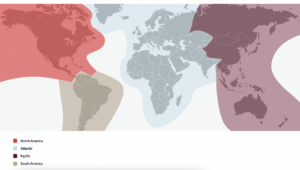The most important part of a rewards program is obviously redeeming your points for free travel. So the most important part of the new Aeroplan program is definitely the pricing system, which is often called the award chart by travel rewards enthusiasts. This is how the sizeable stash of points you’ll be able to easily acquire when the program launches in November will become actual flights.
After reading this post, you’ll understand very clearly how it all works.
Let’s get into it.
New Aeroplan pricing basics
The pricing in the new Aeroplan program is completely different than in the current program.
The new Aeroplan is a hybrid program, and it is actually hybrid in 2 ways:
- hybrid for Air Canada vs. partner airlines
- hybrid for distance-based vs. region-based
Those are the 2 most important things to understand about the new Aeroplan pricing system.
In very simple terms:
- the price for a flight on Air Canada is different than the price for a flight on partner airlines
- the price for a flight is based on the distance flown, but pricing levels vary by region
It might seem complicated (it certainly is a bit more so than it currently is), but it’s not that hard to master—and the purpose of this post is to show you in a very concrete way how you can understand it.
We’ll focus on the price in points: we’ve already covered thoroughly that all cash surcharges are being eliminated entirely, one of the best features of the new Aeroplan.
Unlike the very simple current Aeroplan chart, pricing now varies greatly based on your departure city. That means it’s harder for us to generalize in these posts, given the fact that the 3,000-mile distance between our readers in Vancouver and those in St. John’s makes a huge difference when the price is based on the distance flown.
That said, I’ll show you how the pricing works as simply as possible so you can know exactly how to figure out the price of any flight, but this post will not cover why it works this way or anything like that. Of course, if you want some background and more explanation behind each aspect, the overview post about the new Aeroplan program explained why the pricing mechanism is the way it is pretty thoroughly.
Step-by-step overview of the new Aeroplan pricing (partner airlines)
Let’s start with the issue of Air Canada vs. partner airlines.
For flights on the 30+ partner airlines, it is pretty easy: there are award charts and every specific route costs a fixed amount of points that never changes, the same principle as the current program. For flights on Air Canada, the underlying mechanism is the same, but there is a major difference to explain after.
But let’s start by understanding the basics and focus on flights with partner airlines to first explain the hybrid region-based and distance-based award charts.
By the way, if you’re like us and you like getting outsized value (getting a good deal)… chances are the best way to maximize the value of your points will often be with partner airlines, much like it is now to avoid surcharges (even if surcharges will no longer exist at all).
Ready?
Let’s start.
There are basically 4 main and easy steps:
- Determining the regions (departure & destination)
- Using the appropriate award chart
- Determining the total distance flown
- Finding the pricing level
It really is simpler than it looks.
1. Determining the regions
This is the same thing as the current program (and most airline programs): the first step is to determine the region that applies for your specific route, to see the price.
The world is divided into just 4 geographical regions that are called “travel zones” in the Aeroplan program:
- North America
- South America
- Atlantic
- Pacific
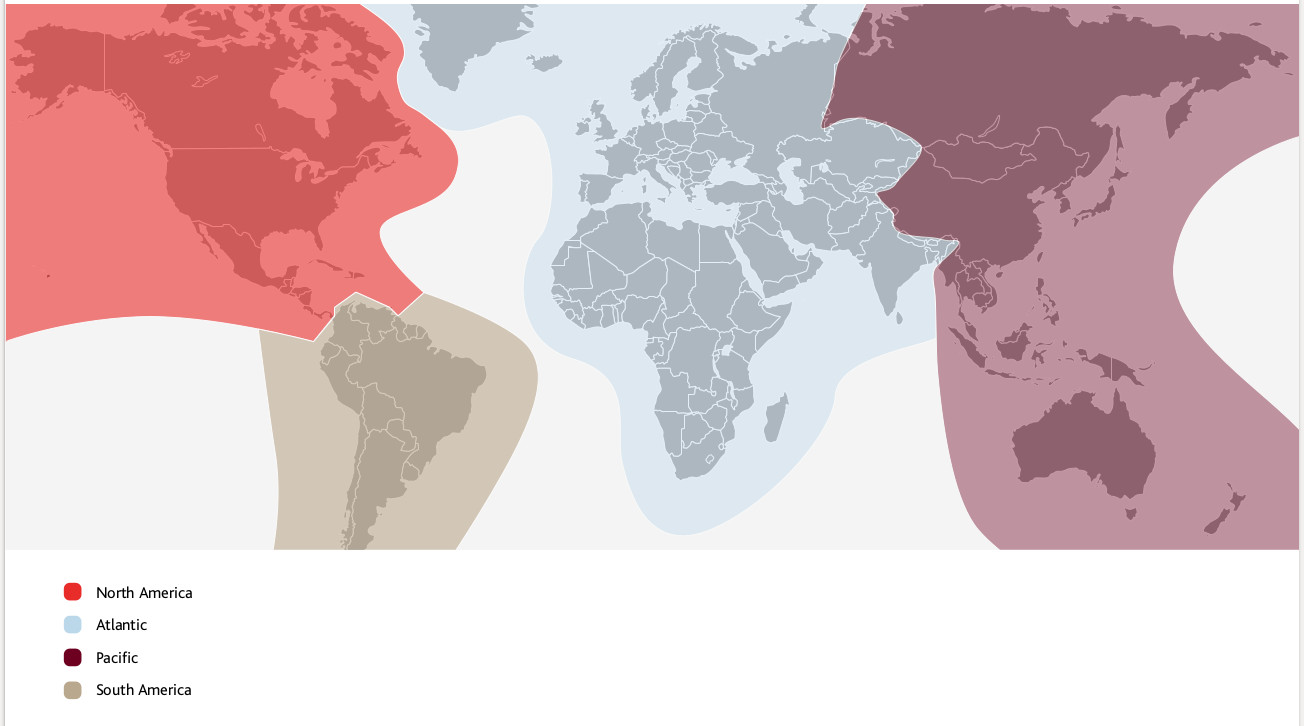
The split is pretty logical overall, the only subjective part is the border between the Atlantic and Pacific zones. That border actually creates interesting opportunities to outsmart the system; we’ll tell you more about that in the next batch of articles about Aeroplan in October.
So that’s pretty simple to start off, right? (the current Aeroplan has 15 different regions!)
2. Using the appropriate award chart
With the current program, the whole process ended right here: there is just one award chart and it is only based on the regions. So all you needed is the departure city’s region and the destination’s region, and there is one price for that combination on that single award chart.
But now, each region has its own separate award chart.
Since there are now 4 zones, there are now also 10 separate award charts:
- 4 for flights within each zone (North America to North America, Atlantic to Atlantic, etc.)
- 6 for flights between each zone (North America to Atlantic, North America to Pacific, etc.)
It might seem like a lot to have 10 award charts… but in reality it’s not too much of a hassle to determine where you’re going and where you’re leaving from (it’s a pretty basic part of planning a trip usually).
And most importantly, while some of us travelers know that positioning somewhere in the world with a cheap flight deal (like those that Flytrippers spots) is a great way to save money (and therefore we might then sometimes use Aeroplan points for flights with a departure point other than North America)…
Most of the time, most of you will be leaving from North America.
So this part of the process is pretty easy, as there are really only 4 options in terms of award charts:
- North America to North America
- North America to South America
- North America to Atlantic
- North America to Pacific
Now that you’ve determined which award chart applies, it’s not that much more complicated.
3. Determining the total distance flown
The current Aeroplan program was only region-based and distance was completely irrelevant.
Now, you need to determine the total distance flown (in miles, the archaic non-metric unit of measure that still rules in the aviation world).
So as an example to illustrate this whole process, let’s take a very simple route (and a great long weekend getaway option): Montreal (YUL) to Washington (IAD).
Montreal to Washington is a distance of 489 miles.
By the way, our favorite tool to easily calculate the distance between two airports is called Great Circle Mapper and is one of the tools that will be in our upcoming 20 useful must-have tools for travel rewards enthusiasts in Canada guide that will be sent exclusively to those who subscribe to our free newsletter specific to travel rewards.
All you need to do is enter the airport code combination and hit “distance” (Google can easily tell you the airport code for any city, and you might enjoy my post about 3-letter airport codes and how they are chosen).

You’ll instantly get the distance in miles.
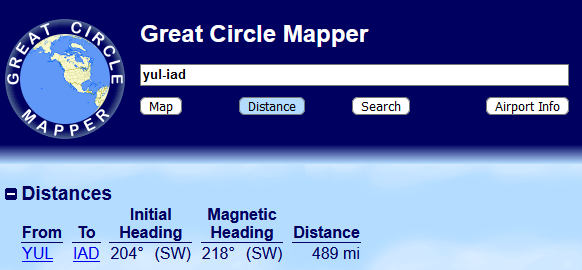
4. Determining the pricing level
You now have everything you need. So let’s finally take a look at the new Aeroplan award charts (all 10 are on that page, so bookmark it)!
You’ve probably caught on to the fact that award charts include different pricing levels (or distance radiuses) based on the distance.
By the way, each of the 10 award charts works exactly the same. The only things that change from one chart to another are the distance radiuses and prices themselves (they’re specific to each region, that’s the whole reason there are 10 charts instead of just 1).
So in our example, we need to use the “North America to North America” award chart since both Montreal and Washington are obviously located in North America.
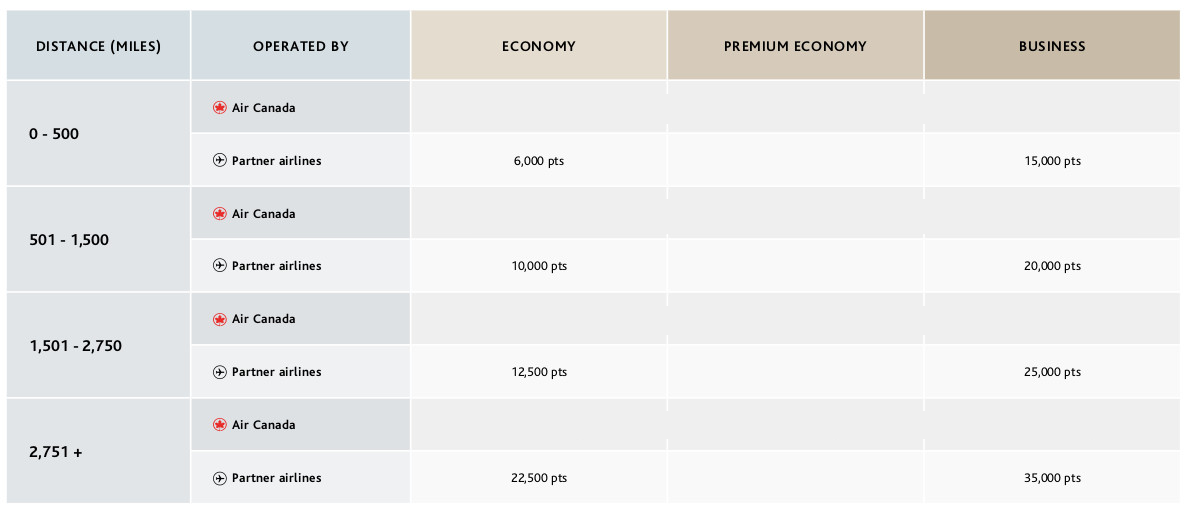
So there are 4 variables in the award charts:
- the distance flown
- the operating carrier
- the seat class
- the price
For the carrier, as you can see (even if I blacked out the Air Canada lines so you don’t get distracted right away) that specific feature is pretty simple: for each distance radius pricing level, there is simply a line for partner airlines and a line for Air Canada.
What you see on the right is that you can book different seat classes, just like before. You’ll notice that premium economy seats are only bookable on Air Canada—just like in other travel zones, first class seats (not the same thing as business class) appear and are only bookable on partner airlines.
The distance and price are the most important.
I think the above chart pretty much speaks for itself, but still: the distance flown (the leftmost column) determines the price (the columns on the right).
So back to our example, the 489-mile flight from Montreal to Washington.
That falls into the first pricing level (0-500) and therefore an economy seat between Montreal and Washington will cost you just 6,000 points one-way on partner airlines, like US-based Star Alliance member United Airlines.
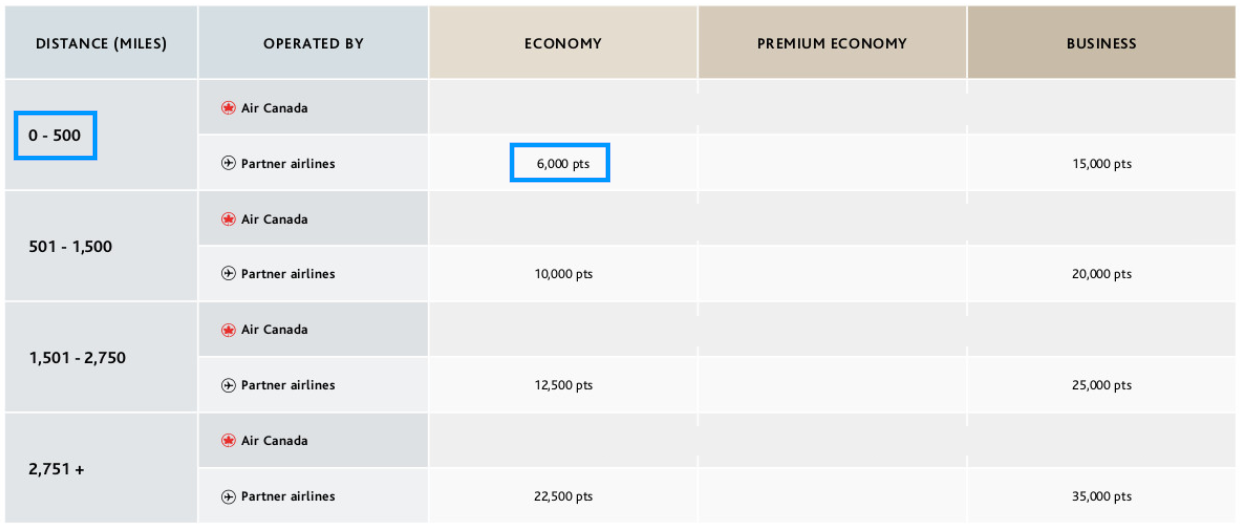
It’s that easy.
Okay, there is one last detail.
The distance means the total distance flown. So a connection that deviates a bit too much from the direct route could add enough distance to bump you to the next pricing level if you’re close to the upper threshold. United flies direct from Montreal to Washington, so that’s not an issue in this case.
But let’s look at another quick example so I can show you what I mean: Montreal to Miami (MIA), which is 1,404 miles. That is in the second pricing level (501-1,500). But United does not fly directly from Montreal to Miami.
If your connection is in Washington, it’s almost a straight line, it is barely a detour… so both flights total 1,410 miles instead of 1,404 for the direct routing.
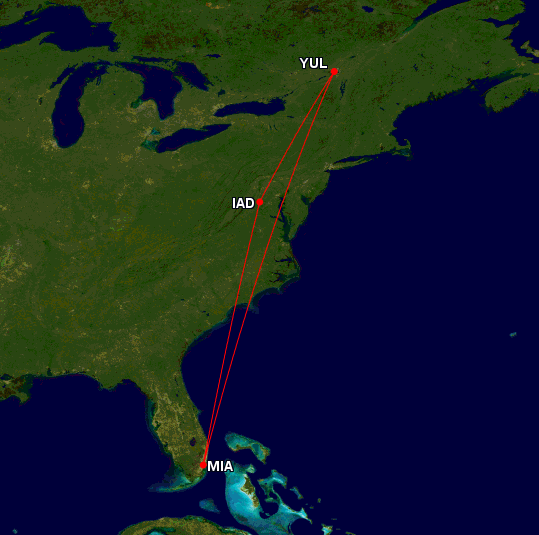
Your total distance remains within the same pricing level, so there is no problem.
But let’s say the only seat availability you could find from Montreal to Miami was via Chicago (ORD). Then you are adding a lot of distance… and your flight would then cost you more points, even if it is the same departure and same destination. Because your total distance ends up over 1,500 and within the following pricing level.
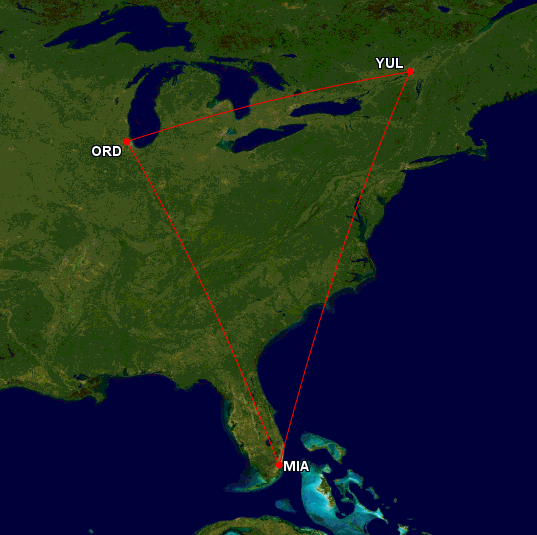
That’s the main difference with the current region-based Aeroplan award chart: whether you stopped, whether you do a big detour (and in fact, your entire routing), that was all completely irrelevant.
And that’s also the main difference with the British Airways Avios program (the second-best airline rewards program for Canadians, as mentioned in our free cheat-sheet about the essential programs to sign up for). That program is also distance-based, but each individual segment is priced separately, based on that segment’s distance.
For Aeroplan, segments are not priced and calculated separately: just the total cumulative distance flown will determine the price based on that region’s award chart.
Step-by-step overview of the new Aeroplan pricing (Air Canada)
Let’s start with the good news: steps 1 to 4 are exactly the same for flights on Air Canada:
- Determining the regions (departure & destination)
- Using the appropriate award chart
- Determining the total distance flown
- Determining the pricing level
Now, the bad news: once you’re at Step 4, the pricing is completely different than it is with partner airlines (while in the current Aeroplan program, the cost in points was the same whether it’s on Air Canada or on partner airlines, with just one exception for short-haul North American flights).
And look: when I say that the pricing is different for Air Canada’s own flights, I don’t mean that it’s something simple like the pricing levels simply being different.
No, flights on Air Canada are now priced dynamically.
What does that mean? In short, there is no longer a fixed price that is guaranteed to be the price you pay.
Understanding the dynamic pricing for Air Canada flights
Here is the same North America to North America award chart as in the example above, now with the Air Canada prices no longer redacted.
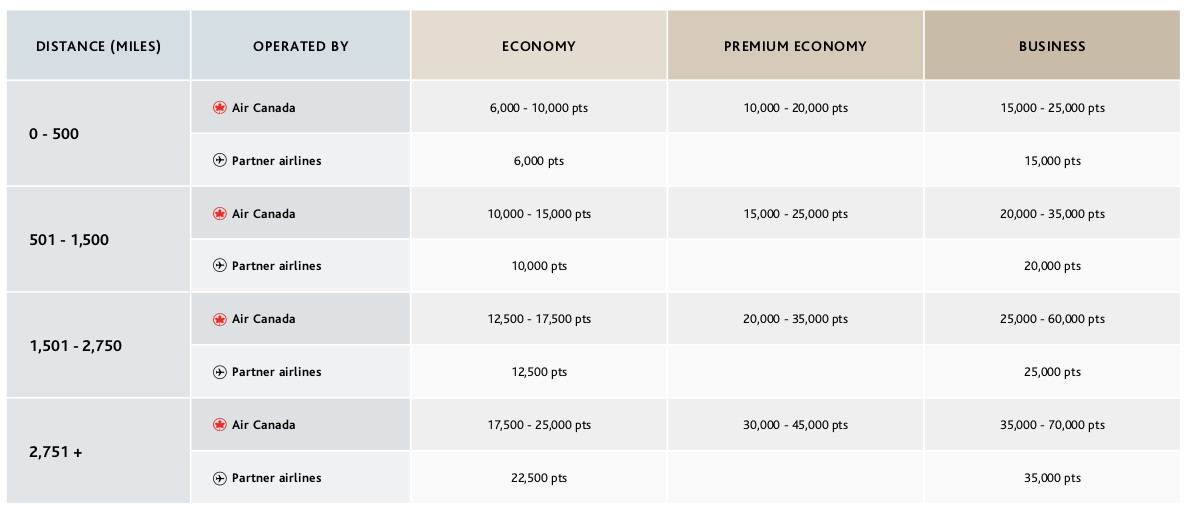
So you might be thinking “hey that’s not too bad, it’s simply a range instead of a fixed price.”
Not so fast…
The pricing range provided is only for approximation purposes, to help you plan your redemptions. The pricing range is not the minimum and maximum price.
In short, Air Canada flights will fall into a certain pricing range 80-90% of the time. That is what the pricing range in the award charts are.
For a 489-mile long Montreal to Washington flight, 80-90% of the time, flights on Air Canada will cost between 6,000 and 10,000 points (compared to 6,000 points always on partner airlines, which is why those who want to maximize will likely get more value with partner airlines, as I said).
The more expensive the flights are in cash, the closer you’ll be to the top of the range. The cheaper the flights are in cash, the closer you’ll be to the bottom of the range.
That is dynamic pricing, ladies and gentlemen.
If you want to travel to Miami during Spring Break and book at the last minute, that will almost certainly be part of the 10-20% of flights priced way over the top of the provided range. In theory, prices could also sometimes be lower than the bottom of the threshold… yeah, right. We’ll have to see about that. Mark me down as extremely skeptical. But hey, who knows? I hope I’m wrong.
I think the best we should realistically hope for is for prices at the low end of the range to be somewhat common. In theory, Air Canada said that those should be just as easy to find as seat availability is now in the current system. If true, that’s honestly pretty good. The caveat is that this can be true overall, but certainly won’t be for each specific route.
So, that wasn’t too bad, right?
How this works is not too hard to understand when you look at this way.
The concept is simple, but you probably have many many other questions.
Common questions about Air Canada dynamic pricing
Now you might be wondering:
- Why bother if even the lower end of the range is the fixed price on partner airlines?
- How often the prices will be on the lower end of the pricing range?
- Will Aeroplan points now have a fixed value when used on Air Canada?
- What happens if an itinerary has both Air Canada and a partner airline?
Why bother if even the lower end of the range is the fixed price on partner airlines?
I know, right? Well, actually it’s not that surprising. Yes, even the lowest price you are likely to get on Air Canada is almost always the same price as the exact same routing on partner airlines—and most of the time it will be higher on Air Canada than on partner airlines.
So many asked us why anyone would book with Air Canada instead of with partner airlines. The answer is… for the same reason that most people use the current Aeroplan program for Air Canada flights even if it’s arguably even worse of an unfavorable gap now.
(Yes, many have also asked us why Air Canada’s own rewards program does not incentivize flights on Air Canada more… but the fact is that they do incentivize them a lot more in this new program than in the current one.)
In the current program, flights on Air Canada have horrible and expensive surcharges. Yet most people use Aeroplan to book flights on Air Canada instead of flights on United Airlines (or the many other partners with no surcharges).
In one sentence, the explanation is that more people care more about convenience than they care about getting the most value. Air Canada has more flights, Air Canada has nonstop flights… so people book on Air Canada even if it’s not the best way to maximize the value of Aeroplan points.
Now with this new program, every single seat on Air Canada flights is available. No need to find availability. Again, most people will choose convenience. It’s no wonder so many people believe in the myth that travel has to be expensive: very few understand that being flexible makes it so easy to save money. Very few understand that travel isn’t expensive: it’s wanting travel to be convenient that is expensive.
So we’ll have a detailed post on the topic in the coming weeks, but for now, that’s the gist of it. If you can find prices on Air Canada that are at the lower end of the pricing range, of course you’re definitely better off booking flights on Air Canada (to avoid the new $39 partner booking fee). But if the price is higher on Air Canada, unless you want more convenience instead of more value, it’s true that partner airlines will often be a better use of Aeroplan points… just as they are now in most cases.
How often the prices will be on the lower end of the pricing range?
This is one of the only mysteries left about the new Aeroplan, as Air Canada has been extremely transparent and upfront with every single aspect. But there simply is no way of knowing what the dynamic pricing will look like until the program goes live and the new prices appear online.
The best-case scenario would be for prices at the lower end of the range to be easy to find if you’re flexible on dates, just like available seats are currently easy to find. But only time will tell.
One thing to note is the preferred pricing benefit. It is a benefit that will come with every co-branded Aeroplan credit card and is supposed to give cardholders discounts on dynamic pricing, but that too is a very vague concept at this stage. It sounds promising though, and Aeroplan executives really insisted that this would be valuable. That also remains to be seen.
You can read a bit about preferred pricing at the end of the post about the new Aeroplan credit cards but we’ll have more soon.
Will Aeroplan points now have a fixed value when used on Air Canada?
You’d think so, right? That’s kind of the whole point of dynamic pricing. But it’s not quite as simple. Yes, as you might have read in the detailed explanation about the dynamic pricing model, both great uses and terrible uses will likely be eliminated in favor of averaging out everything into average uses.
But Air Canada won’t go so far as to attribute a fixed value like bank rewards programs do (for example, Scotia points are worth a fixed amount of 1¢ per point when applied to flight purchases, it’s low, but it’s simple and clear).
The value of an Aeroplan point for Air Canada’s dynamically-priced flights (as a reminder, the value is defined as how much money you save by using a point) will vary somewhat, based on factors we’ll likely never know.
And as I just said, the exact pricing will be known in November. And most importantly, the value will evolve and be modified constantly, so our Flytrippers valuation of Aeroplan points will likely have to be updated more frequently.
What happens if an itinerary has both Air Canada and a partner airline?
Let’s end with this very good question. Any and all partner airlines can be combined in any way (and the new search engine is supposed to be one of the best on the market), so how will that work in terms of pricing?
Well, if you mix-and-match various partner airlines together (Star Alliance or non-alliance), of course, that is the simplest scenario: the pricing will not change at all, it’s strictly based on the region and distance.
The issue is if you mix Air Canada and partner airlines (avoidable if you live in a major city, not so much if you don’t).
Well, the answer is simpler than it seems. The price will be calculated proportionally, based on what percentage of the total distance flown is operated by each carrier. In other words, it is a weighted average.
This is where there’s a clear disadvantage if you live in smaller cities with few partner airlines (we’ll soon share a cheat sheet with the list for all Canadian cities).
Here’s an example: you live in Ottawa, so you book Ottawa to Montreal on Air Canada, and Montreal to Zurich on SWISS (you could’ve booked on United to avoid Air Canada entirely, but let’s pretend you didn’t).
The total distance flown is 3,831 miles, which is in the first pricing level in the North America to Atlantic award chart (the most unfavorable of charts, by the way).
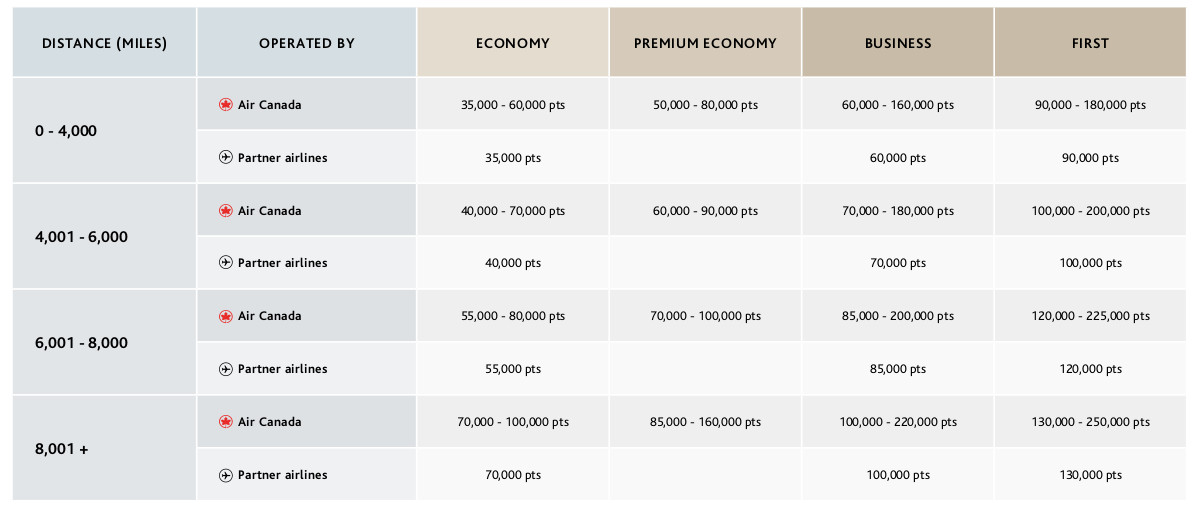
Your price if you had flown exclusively on partner airlines would have been 35,000 points in economy. If you had flown exclusively on Air Canada, the pricing range would have been 35,000 to 60,000 points.
So Aeroplan will calculate how much that hypothetical flight would have cost in total on Air Canada. Let’s say the flight was not too expensive in cash, but not too cheap either. Let’s say the Air Canada dynamic price would have been 45,000 points.
Ottawa-Montreal is 94 miles and Montreal-Zurich is 3,736 miles. The price will be a simple weighted average: in other words, the Ottawa-Montreal flight is just 2.5% of the total distance flown and Montreal-Zurich is 97.5%.
So you’ll pay the sum of:
- the 2.5% of the hypothetical 45,000-points Air Canada-only price
- and 97.5% of the 35,000-points price for partner airlines
That will give you a total price of 35,250 points, just barely above the partner price of 35,000. That is obviously the rare best-case scenario since Ottawa is so close to Montreal. The further away from a hub you live, the more of a premium you’ll pay (but you’ll have more seat availability for your overall journey than you currently have, as explained in the pros and cons).
If the price of the cash flight from your city is higher than average, it will cost you even more. But again, if you’re flexible, you should be able to find the lowest prices and keep the incremental cost of flying out of a smaller airport to a minimum. We’ll have more pro tips on the topic as we approach November!
Want to get more content about Aeroplan?
Summary
This is how the Aeroplan pricing now works, given how the program is now hybrid on two fronts: there are separate systems for partner airlines and for Air Canada, and the pricing is both region-based and distance-based.
Want more info on the Aeroplan program? Tell us in the comments below.
Explore awesome destinations: travel inspiration
Learn pro tricks: travel tips
Discover free travel: travel rewards
Featured image: landscape in Switzerland (photo credit: Andreas M)
Advertiser Disclosure: In the interest of transparency, Flytrippers may receive a commission on links featured in this post, at no cost to you. Thank you for using our links to support us for free, we appreciate it! You allow us to keep finding the best travel deals for free and to keep offering interesting content for free. Since we care deeply about our mission to help travelers and our reputation and credibility prevail over everything, we will NEVER recommend a product or service that we do not believe in or that we do not use ourselves, and we will never give any third-party any control whatsoever on our content. For more information on our advertiser disclosure, click here.


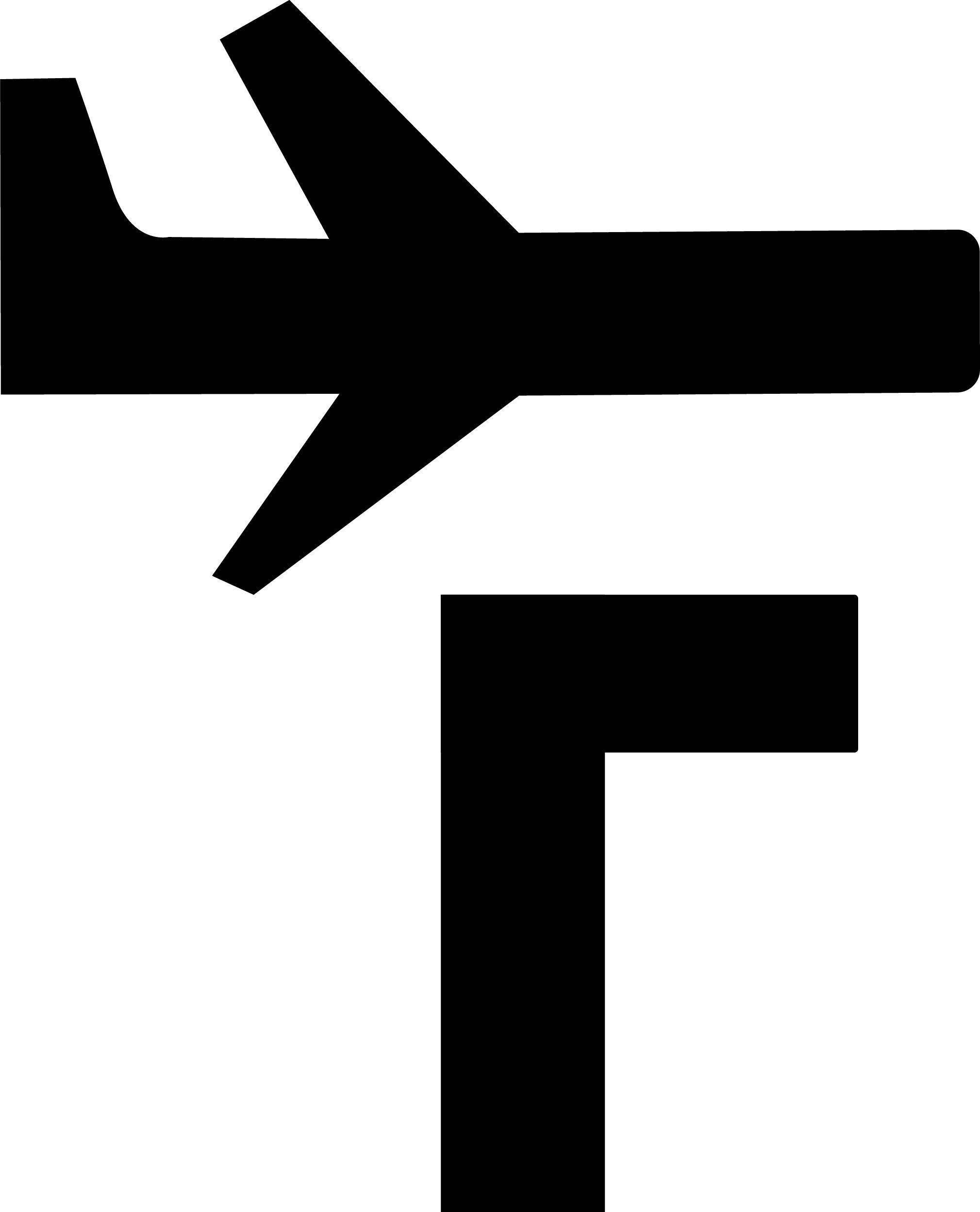 NEW AEROPLAN PROGRAM
NEW AEROPLAN PROGRAM